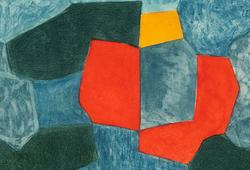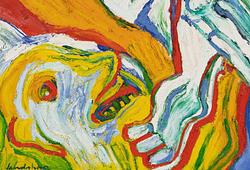A Chinese gilt wood lantern with brass shade, Qing dynasty, 19th century.
The stand emerging from an elaborate stepped base, the four slab feet carved and gilt with scrolling clouds and leiwen, separated by four dragon heads emerging from the center pole decorated with further clouds wisps, the feet joined to the pole by ornate tapering spandrels of archaistic angular scrolls with details picked out in gilt, the long staff carved in high relief with a brightly gilt, five-clawed dragon boldly coiled amid further clouds and extending the entire length of the pole decorated with a gilt pattern, the fierce head of the mythical beast arching over the top to form the lantern support; together with an associated brass lantern with a pierced decoration with a dragon, symbols and cloud formations. Wired for electricity. Converted to a floor lamp. Height 175.5 cm.
Not tested for function. Wear. Chips.
Alkuperä - Provenienssi
Property of a private Swedish collector.
Näyttelyt
Compare, lantern stands sold at Sothebys, Important Chinese Art 12 September 2018 New York. Lot no 274.
To see round brass lanterns see lot 600, Christies, 28 April-7 July 2003 Live auction 2138. The Imperial Sale, Fine Chinese Ceramics and Works of Art.
Kirjallisuus
Lantern stands of this kind were used for nighttime illumination of one of the many rooms of the grandest residential complexes. Although glass was introduced in the 18th century it is most likely that the present stand originally suspended a globular inside-painted horn lantern. The dragon-head base and coiled-dragon-form stand is a motif seen in other media in the Qianlong period, for example a large cloisonné and gilt stand from the collection of Samuel Avery, illustrated in Avery Collection of Ancient Chinese Cloisonnes, Museum of the Brooklyn Institute of Arts and Sciences, Brooklyn, 1912, cat. no 84.

















































































